Abura Kappo is a new dining concept within the renowned Hashida Singapore that offers a unique and innovative dining experience. Nestled along the vibrant Amoy Street, Abura Kappo shares the same entrance as Hashida Singapore, which is helmed by chef Kenjiro “Hatch” Hashida. Having recently unveiled its doors last December, Abura Kappo introduces a captivating fusion of creativity and tradition, all centered around the element of oil.
Read more: [SG EATS] Abura Kappo at Amoy Street | A Novel Restaurant-in-a-Restaurant Concept within Hashida Singapore
There are three private dining rooms available- Room A which accommodates 12 guests, Room B with a capacity for 7 guests , and Room O (Abura Kappo) designed for gatherings of up to 6 guests. So to reach to the designated Abura Kappo room, diners will take a serene stroll down a zen lane within Hashida Singapore that adds an element of anticipation.
Abura Kappo’s fixed 13-course menu, priced at S$200++ per person, showcases a delightful blend of traditional Japanese flavors with a contemporary twist. Join me as I delve into the beautiful evening here.
Monaka
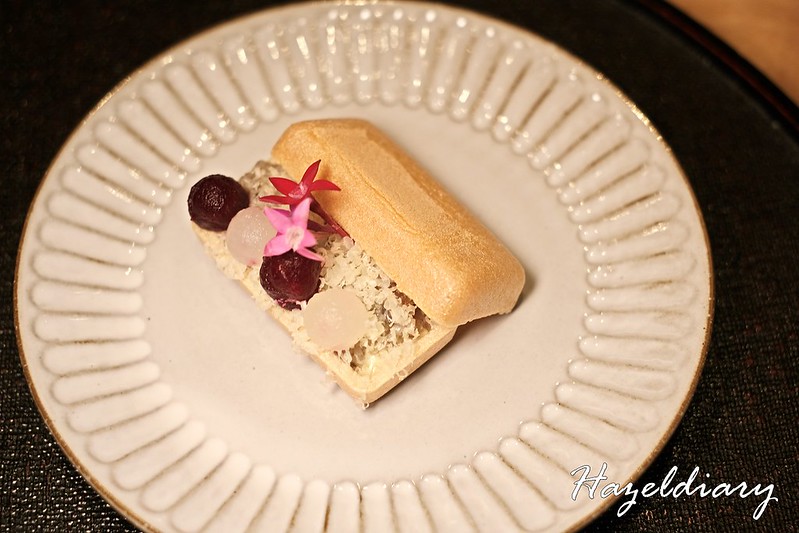
A crispy wafer filled with a creamy blend of blue cheese and Comté cheese, mushroom sauce, and pearls of roasted beetroot and Japanese radish.
Lamb x Squid

A surprising combination of fresh raw lamb paired with squid, accompanied by Hashida’s signature gin salt. I thought the combination was interesting and the chef has nailed it well.
Camembert
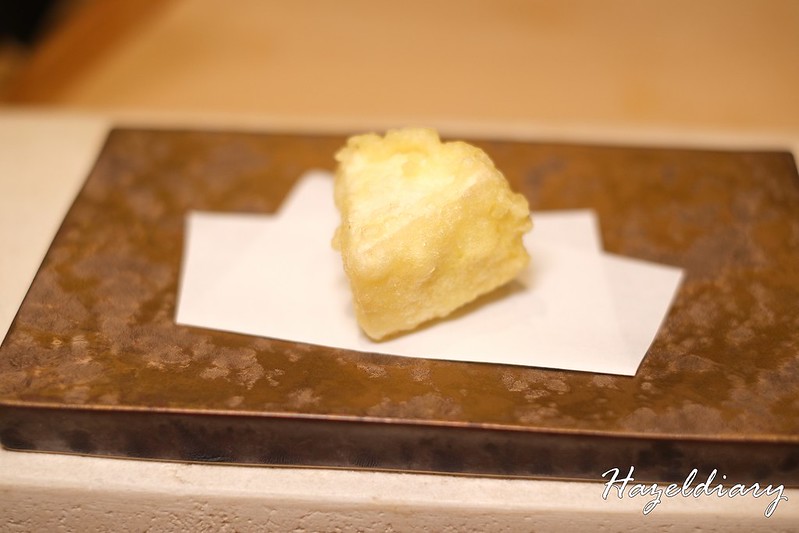
A delightful course featuring Camembert cheese tempura paired with the citrusy mint of kinome leaves. One of my favourite of the night.
Tuna Consommé
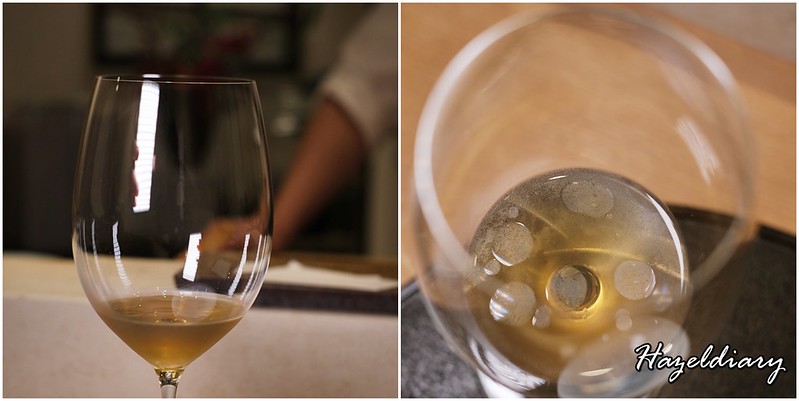
I was instructed to gently swirl the glass containing the tuna consommé, which I thought it was wine at the first place. The swirl is to allow the aromatic spring onion oil to meld with the essence of Japanese bluefin tuna. Splendid!
Managatsuo

Moving on to the Managatsuo, a dish spotlighting the silver pomfret. This delectable creation is served with two flavorful sauces – a zesty, homemade onion sauce and a rich tempura sauce.
Ebi Toast

Deviating from traditional bread with a savoury house-made tamagoyaki and angel shrimp paste. Visually pretty and flavours are on point.
Tebagyoza
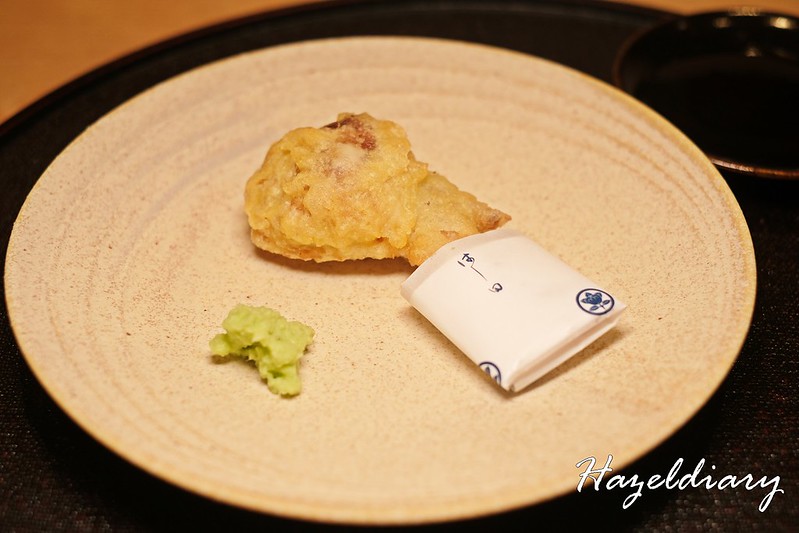
A twist on Tebagyoza, featuring a crisp deboned chicken wing generously stuffed with glutinous rice and egg. It is inspired from Oyako-don dish.
Wagyu Beef Tempura

Hokkaido Tokachi Wagyu beef wrapped in green shiso leaf, deep-fried to perfection, and drizzled with a sauce made from balsamic vinegar and pomegranate juice. Give a dip with with the Sakura salt and red shiso (yukari) salt that served on the side for more flavours.
Duck Salad

A refreshing intermission in the culinary journey so far. This course features slices of succulent duck breast accompanied by pickled turnip and persimmon, offering a delightful blend of flavors and textures.
Soft Soba Taco
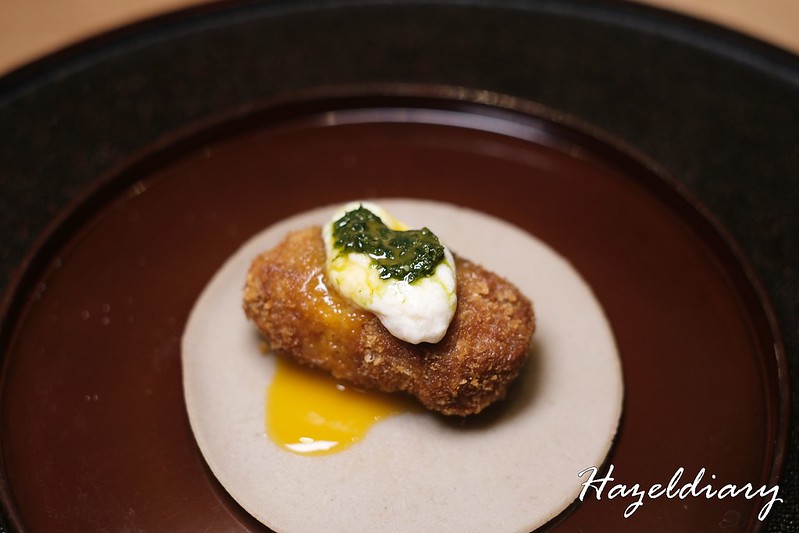
The Soft Soba Taco is a pleasantly surprising fusion dish that brings together a handmade buckwheat tortilla with a touch of sukiyaki inspiration
There are also inspirations from sukiyaki with the deep-fried cutlet of minced Wagyu topped with tofu emulsion and then drizzled over with egg yolk.
Oden Tempura

Oden Tempura takes inspiration from the Japanese classic, with radish and tomato stewed in dashi before being deep-fried to a golden perfection. This unique preparation is a first for me, and I must say, it’s surprisingly delightful.
Donabe
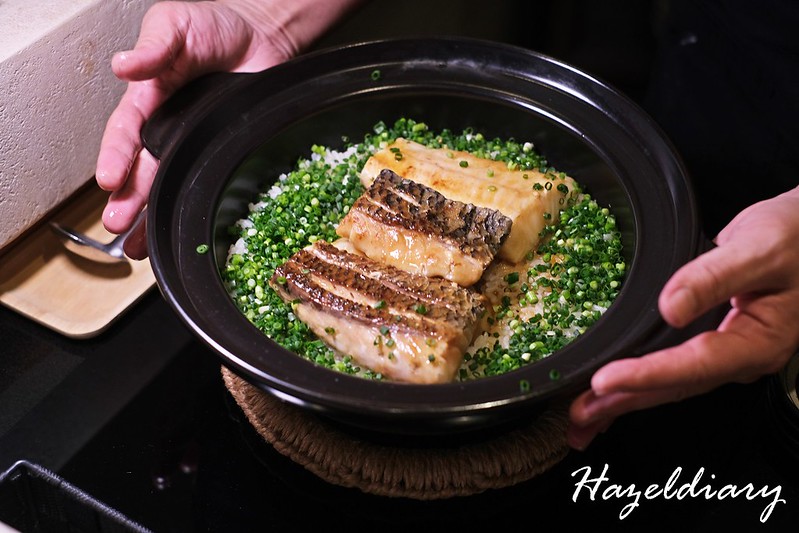

Presented in a donabe, the dish features plump, glossy, and sweet Nanatsuboshi short-grain rice, paired generously with a selection of fresh seafood. The bowl is accompanied by a trio of toppings and sheets of roasted seaweed. Among them is the Spicy Tuna, adorned with golden tempura crumbs; Prawn Tempura, served with tempura sauce resembling a mini tendon; and a mix of julienned radish, shiitake mushroom, spinach, and burdock root arranged in the style of Korean Kimbap.
The concluding savory course offers a playful DIY experience, allowing you to customize the donabe with condiments and accompanying ingredients to your liking.
Dessert

The dessert presentation unfolds in two parts. First, we had the shiitake mushroom-infused chocolate paired harmoniously with house-made vanilla ice cream, cleverly shaped to mimic a mushroom cap. Next is the slice of dried persimmon served alongside house-made matcha ice cream.
For those still craving more, ala carte add-ons such as Uni & Caviar Tempura, Ika & Caviar Tempura, and Kani Tempura are available.
Abura Kappo’s innovative approach to its “oil”-inspired menu, combined with unexpected twists and delightful flavors, offers a refreshing departure from traditional omakase experiences. The intimate setting and creative dishes make it a must-try for those seeking a fun and unique culinary adventure in the heart of Singapore.
Address: Abura Kappo
77 Amoy Street
Singapore 069896
Tel: +65 8129 5336
Opening Hours
Tuesday: 7.00pm to 10.30pm
Wednesdays to Sundays
Lunch: 12.00pm to 3.00pm
Dinner: 7.00pm to 10.30pm
Closed on Mondays
![[SG EATS] Abura Kappo at Amoy Street | A Novel Restaurant-in-a-Restaurant Concept within Hashida Singapore [SG EATS] Abura Kappo at Amoy Street | A Novel Restaurant-in-a-Restaurant Concept within Hashida Singapore](https://hazeldiary.com/wp-content/uploads/2024/02/Abura-Kappo-Amoy-Street-672x372.jpg)
![[SG EATS] Experience Colonial Elegance with Fine Cantonese Dining at Chef Chan’s Private Dine, Led by Resident Chef Wong Hong Loong at 35 Scotts Road [SG EATS] Experience Colonial Elegance with Fine Cantonese Dining at Chef Chan’s Private Dine, Led by Resident Chef Wong Hong Loong at 35 Scotts Road](https://hazeldiary.com/wp-content/uploads/2024/01/Chef-Chans-Private-Dining-Abalone-with-Caviar-and-Maitake-Mushroom-“Kung-Fu”-Soup-672x372.jpg)
![[SG EATS] Usher in A Prosperous Year of The Rabbit with Xin Cuisine Chinese Restaurant | Holiday Inn Atrium [SG EATS] Usher in A Prosperous Year of The Rabbit with Xin Cuisine Chinese Restaurant | Holiday Inn Atrium](https://hazeldiary.com/wp-content/uploads/2022/12/Xin-Cuisine-Holiday-Inn-Atrium-IHG-hotel-Sliced-foie-gras-with-roasted-chicken-mango-sauce-672x372.jpg)
![[SG EATS] Blossoming Fortune This Lunar New Year at Golden Peony | Conrad Centennial Singapore [SG EATS] Blossoming Fortune This Lunar New Year at Golden Peony | Conrad Centennial Singapore](https://hazeldiary.com/wp-content/uploads/2022/12/Yam-Abacus-Seed-Golden-Peony-Conrad-Singapore-672x372.jpg)
![[SG EATS] Bountiful Beginnings This Lunar New Year at Four Seasons Hotel Singapore [SG EATS] Bountiful Beginnings This Lunar New Year at Four Seasons Hotel Singapore](https://hazeldiary.com/wp-content/uploads/2022/12/Jiang-Nan-Chun-Four-Seasons-Hotel-Singapore-Prosperity-Yusheng-with-Ice-Plant-672x372.jpg)

![[SG EATS] Prosperity in Bloom This Lunar New Year with Shangri-La Singapore [SG EATS] Prosperity in Bloom This Lunar New Year with Shangri-La Singapore](https://hazeldiary.com/wp-content/uploads/2022/12/Shang-Palace-Shangri-La-Abundance-Pen-Cai-672x372.jpg)
![[SG EATS] Hop into a Bountiful Year of the Rabbit at Man Fu Yuan | InterContinental Singapore [SG EATS] Hop into a Bountiful Year of the Rabbit at Man Fu Yuan | InterContinental Singapore](https://hazeldiary.com/wp-content/uploads/2022/12/InterContinental-Singapore-Man-Fu-Yuan-Yusheng-672x372.jpg)
![[SG EATS] An Ethereal Garden of Blooms Lunar New Year with Madame Fan | The NCO Club [SG EATS] An Ethereal Garden of Blooms Lunar New Year with Madame Fan | The NCO Club](https://hazeldiary.com/wp-content/uploads/2022/12/Madame-Fan-JW-Marriott-Poon-Choi-672x372.jpg)